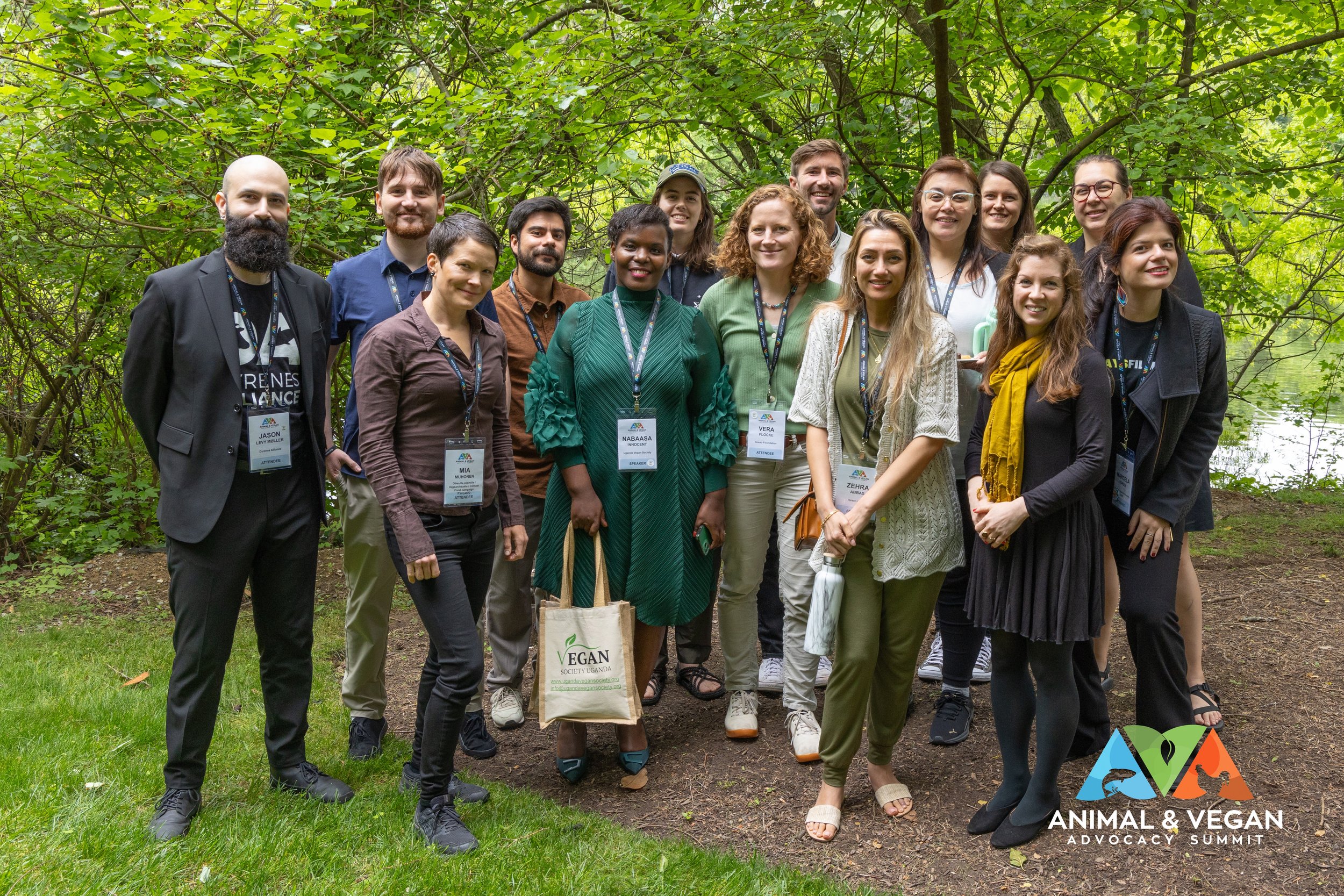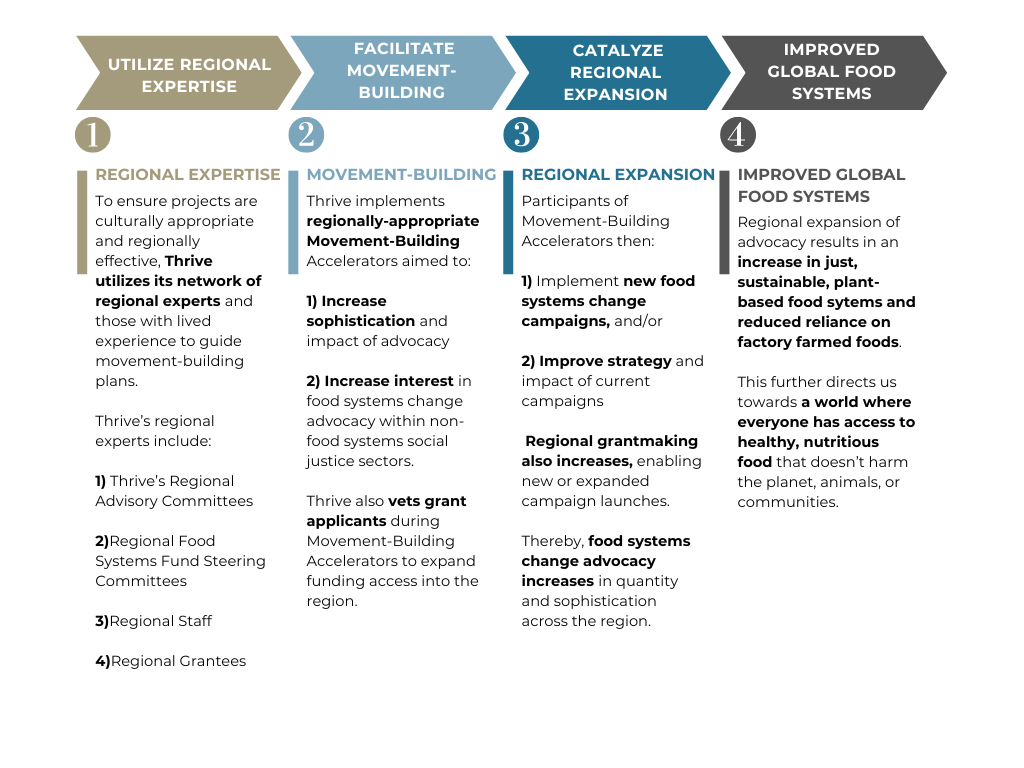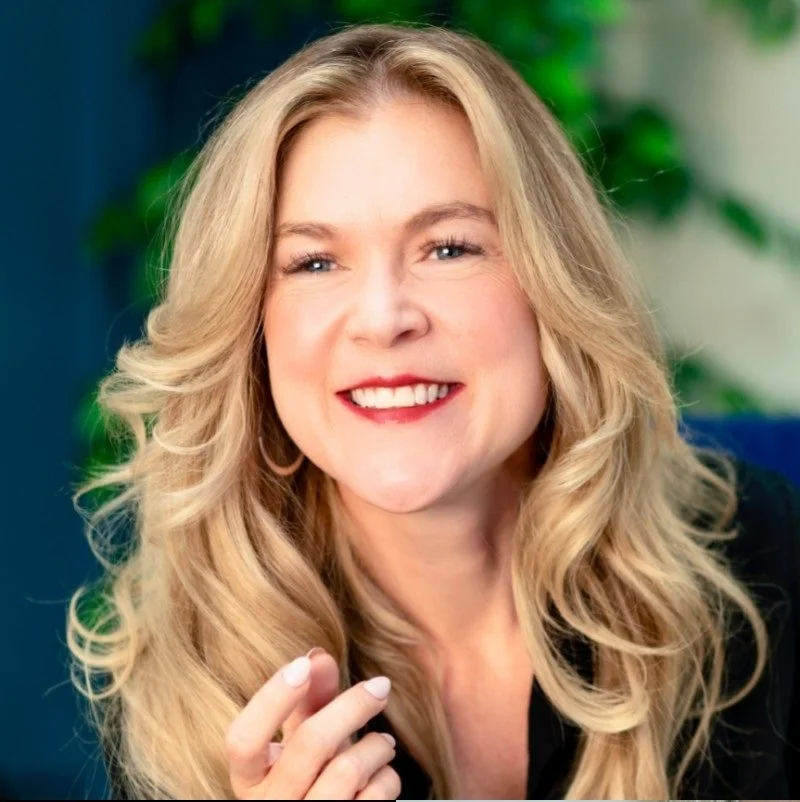Thrive’s Strategy, Grantmaking Process,
and History
Thrive’s CEO and Founder has nearly 20 years of global philanthropic experience with a deep focus on Global South regions. We have a team collective 60+ years in food systems work, and a pool 40+ expert advisors from 20+ countries to support with our due diligence and strategy.
ON THIS PAGE:Strategy | Grantmaking Approach
Grant Review Process | History
Thrive grantees, CEO, staff, and board
from 11 countries meet in USA.
THRIVE’S STRATEGY
Thrive Philanthropy’s strategy is straightforward.
By tapping into regional expertise and networks, we ensure grantmaking is directed as effectively as possible to improve food systems worldwide. Grantmaking is coupled with increasing the size and sophistication of regional movements through strategic movement-building and capacity-building catered to regional needs and cultures. Thus, by advancing regional movements and regional leadership, Thrive can reduce reliance on harmful industrialized animal farming and increase just, healthy, plant-based food systems worldwide.
Thrive’s CEO and Founder has nearly 20 years of global philanthropic experience with a focus on Global South regions and extensive living experience in Global South giving Thrive deep insight into global giving. We also have a team collective 60+ years in food systems work with staff from 4 continents, and a pool 40+ expert advisors from 20+ countries to support with our due diligence and strategy.
GRANTMAKING APPROACH
Thrive’s CEO and Founder has nearly 20 years of global philanthropic experience and extensive living experience in India and Nepal, and we have a team collective 60+ years in food systems work, and a pool of over 40 expert advisors from 20+ countries to support with our due diligence and strategy.
-
Cause Area:
Thrive funds proposals that that accelerate alternatives to industrial animal agriculture and create plant-friendly food systems.
Tactics:
Thrive prioritizes tactics that:Reduce demand and/or consumption of animal products
Increase the accessibility and/or demand of plant-based products
Reduce operations of factory farms through public, corporate, or institutional targets or systemic policy change.
Examples of tactics Thrive might grant:
Institutional or corporate reduction in the use of animal products
Community-driven plant-based food systems to reduce reliance on animal products
Mass public awareness campaigns to reduce demand for animal products
Strategic policy change that reduces demand for animal products or reduces operations of factory farms.
Other regionally relevant innovative approaches.
As a global grantmaker, we recognize different countries and cultures require different approaches. As such, we fund a variety of tactics depending on what is impactful in the region.
Organization Size:
Thrive primarily funds grassroots and mid-size organizations. -
Thrive Philanthropycurrently grants about 80 countries in every continent except Antartica. Currently, we aren’t funding within the United States so we can focus on regions of the world that have historically had less access to funding. Click here to see our granted countries.
Because factory farming is a global issue, Thrive does not currently prioritize a specific region. However, we typically focus on regions that have been historically neglected in funding and/or currently have a limited plant-based food systems change movement. These regions are commonly in the Global South.
Also, at times we might focus more on specific regions if we have a foundation partner that has contributed to our grantmaking pooled fund for a specific region.
-
Thrive Philanthropy is one of the few grantmakers that works to replace factory farms with plant-based food systems on a global scale using equitable, decolonization, trust-based approaches to philanthropy.
We believe our impact is driven by not only who we fund but also how we fund. Our funding approach includes:Centering Grantee Success.
We recognize that Thrive’s success is entirely dependent on grantee success. We commit to centering grantees’ success through strengthening grantee networks, skill sets, fundraising, and more.Dismantling Power Imbalances.
We intentionally dismantle donor/grantee power imbalances, weave race and gender equity into our work, and build strong, long-term partnerships with grantees. This approach ensures non-colonialistic and unbiased grantmaking and support, thereby funding impactful, culturally appropriate projects.Increase Funding Accessibility.
We dismantle funding accessibility barriers so that high-impact organizations worldwide have access to funding opportunities to grow advocacy efforts. We offer unrestricted funding when feasible and reduce grant administrative burden, enabling grantees to focus more of their valuable time on advocacy.
GRANT REVIEW PROCESS
-
Stage 1: Initial Review:
In the initial review stage, we determine if the applicant aligns with Thrive’s mission and grantmaking criteria. If so, we review the strategy broadly to get a general idea of whether it appears to have high impact potential and decent cost-efficiency. At this stage, several proposals are generally declined because they do not align with Thrive’s mission or grantmaking criteria.Africa Preliminary Stage:
Due to the special nature of Africa grantmaking, including the very high number of Africa-based proposals we receive and the unfortunate prevalence of corruption in the region, Africa-based proposals often go through a preliminary stage before reaching the initial stage. This preliminary stage includes participating in one of our Africa-based projects. This gives us an opportunity to meet the applicant and better understand their work. If the organization has a long track record of success and/or multiple references, this Africa-based proposal preliminary stage might be bypassed. -
Stage 2: In-Depth Review
In the second stage, we conduct an in-depth assessment of strategy, goals, and cost-efficiency. This stage often involves email exchanges and/or virtual meetings with applicants.In Stage 2, we assess the following:
Impact and Reach:
Impact and reach are defined by the specific tactic, but it often will look like the number of meals replaced over a period of time, the number of individuals reached, the likelihood of public behavior change, or similar.Cost-Efficiency:
Cost-efficiency also varies by tactic but might look like cost per meal replaced or cost per individual reached. We recognize that calculating reach and cost-efficiency is imperfect, but it does offer an estimate to support us in making generalized judgments.Feasibility and Likelihood of Success:
We assess whether the proposal’s timeline and allocated expenses appear realistic. We consider the skillset of the organization’s staff, the applicant’s track record of success, and, evidence of past success on the applicant’s website or socials.Unmet Niche:
We consider the proposal’s likelihood of filling an unmet niche by determining if similar advocacy work is already being conducted in the region. We are more likely to fund unmet niches and less likely to fund duplicated efforts.Long-Term Viability:
Depending on the nature of the proposal, we consider the likelihood of the project's long-term continuation by considering the applicant’s other fundraising efforts, while also taking into accout the fundraising challenges faced by many advocates.
A point-based decision-making metric may be used to aid in decision-making. Generally, applicants with the highest points are advanced to the next round.
-
Stage 3: Expert & Reference Review
During this stage, on an as-needed basis, we consult with Thrive’s expert advisors including the Thrive Global Advisory Committee and the Thrive Asia, LATAM, and Africa Funding Steering Committees. Advisors provide insights on regional impact, movement needs, political situations, and more. If necessary, an advisor may review the entire proposal.As necessary, we may check applicant references and/or references from past or current funders.
-
Final Stage: Grant Offer
In the final stage, we invite applicants to become a Thrive grantee. In addition to grant funding, grantee partners are offered access to individualized expert coaching, peer networks, and other capacity-building opportunities.
THRIVE’S HISTORY
-
Prior to launching Thrive Philanthropy, Thrive’s Founder and CEO and founding team worked together at a previous organization and oversaw the precursor to Thrive’s grantee portfolio and Thrive Africa Accelerator.
-
Thrive Philanthropy is officially incorporated in the United States with limited philanthropic consultation.
-
Thrive Philanthropy formally launches by transitioning the team, grantee portfolio, and Thrive Africa Accelerator from the previous organization to Thrive. Within its first six months, Thrive expands the plant-based movement in 1 out of every 3 of the world’s countries and expands the plant-based movement in 40% of African countries. See the 2023 Annual Report here and impact page here.
-
Thrive Philanthropy continues to expand and by the end of year 2, Thrive is amplifying the plant-based movement in 1 out of every 2 of the world’s countries and expanding the plant-based movement in 2/3 African countries, and growing.
Thrive also onboards a 15-member international Board of Directors, and LATAM, Asia, and Africa Funding Steering Committees, formalizes its Thrive Food Systems Pooled Grantmaking Fund, begins its Asia movement-building work, and expands its 2 flagship Africa movement-building projects by 350% and 500% since year 1. See the 2024 Annual Report here and impact page here. -
Thrive continues to expand grantmaking and movement-building. Our current impact can be found here.

DONOR TESTIMONIALS
DONATE TO THRIVEJoin us in creating just, plant-based food systems.
Your support to Thrive Philanthropy creates a world with nutritious, sustainable, plant-based food systems, and a world where philanthropy is equitable, effective, and just.











